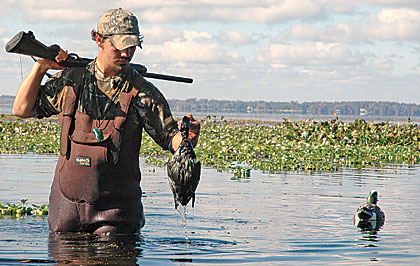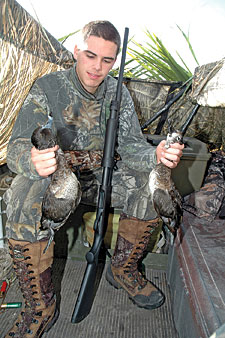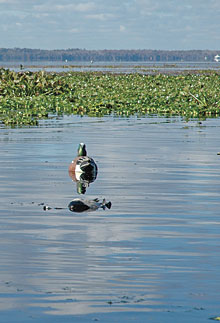October 08, 2010
By John N. Felsher
The Sunshine State boasts huge tracts of prime duck hunting...
By John N. Felsher
 In many places, hunters can safely wade far from shore. |
Legal shooting hours had begun several minutes earlier, but nearly impenetrable fog dared the sun to rise. Cloaked in thick blankets of vapor, we couldn't even see the massive lake spreading before us, even though we stood on its shoreline.
Barely feet away, I could not see my son, Daniel, crouching among cypress trees laden with Spanish moss. While we could see little in the feeble grayish gloom, the fog did not stop sounds from reaching our ears. Unseen whistling wings beat rapidly overhead as the tantalizing sound of splashing echoed through the misty wilderness. Sound carries easily over water on still mornings, making judging distances by ear difficult. Did our feathered quarry swim merely feet away, or perhaps half a mile away? We couldn't tell as we strained to penetrate the all-obscuring and drenching whiteness before us.
Advertisement
Finally, the sun meekly rose, peeling back a few layers of the vaporous shell enveloping us so we could glimpse Lake George. This morning, we claimed a tiny sliver of the eastern shoreline in a stretch of wilderness known as Lake George Wildlife Management Area for our hunt.
As the sun finally started to battle back the fog, we spotted ducks swimming about 100 yards away. Hoping to pop wood ducks whistling down the shoreline, we tossed our decoys in a small cove between a massive mat of weeds and the cypress-lined shoreline before dawn. On this morning, though, ducks preferred landing on the far side of the enormous weedbed. We must change our strategy.
Advertisement
Leaving six wood duck decoys in the pocket between the tangled grass and the trees just in case, we waded out into the matted vegetation, repositioning some wigeon blocks at the outside edge of the matted grass. We hoped the birds we chased off in the process would soon return and bring friends. With decoys behind and in front of us, Daniel and I tried to hide as best as we could in the waist-deep water with no other cover except the dense grass.
Because we really couldn't hide the top halves of our bodies, we merely crouched low in the water and remained as still as possible, keeping our faces down as birds flew near us. Standing in water 3 feet deep, we wished we could devise some sort of brush or camouflaged material attached to floats that we could circle around us.
However, the fog helped hide us. Aided by the still-thick white blanket hovering over the water, we found good shooting. In the next two hours, about as long as it took for the sun to completely burn off the fog, we knocked down a limit of ring-necked ducks that wanted to feed at the edge of the grass.
Lake George Ringers
The second-largest freshwater lake in Florida, Lake George sprawls more than 46,000 acres northwest of Deland. Mostly surrounded by wilderness with a few traces of civilization along its shorelines, the large, shallow lake on the St. Johns River sits on the edge of the 383,000-acre Ocala National Forest. The 38,509-acre Lake George WMA takes up most of the southern and eastern shoreline. In some years, the lake can offer good shooting for ringnecks with a few bluebills, redheads, ruddy ducks or canvasbacks in the mix. At times, large flocks of divers raft up in the middle of the lake. Sportsmen might also bag an occasional teal, pintail or wigeon. Wood ducks fly around the swampy shorelines.
"Lake George can be hit or miss," said Jim Denton, a veteran Florida duck hunter. "If the lake grows up with hydrilla, it can hold ducks. Some years, it's full of ducks. I like to hunt on the south end because it's shallower and has more grass and sandbars. I like to hunt near the trees, but if the water is low, we have to hunt farther out from shore. Sometimes, we wade into the lake."
With a mostly hard, sandy bottom and little depth variation, Lake George allows sportsmen to wade several hundred yards from heavily wooded shorelines, a bonus for waterfowl hunters without access to boats. The lake drops to 10 feet deep in places, but thick vegetation covering large swaths of shallow flats dominate huge portions of the shoreline out several hundred yards. These acres of matted grass provide good feeding grounds for ducks and a multitude of coots.
 Small boats rigged with portable, quick-to-set-up blinds work well in Florida's wetlands. |
"I look for patches of hydrilla, eelgrass or dollar lilies because that's where ducks want to feed," said Brett Howard, a waterfowl guide from Salt Springs, Fla. "I try to find some cane patches near the feeding areas where I can hide the boat. Any place with points and reed patches that stick out pretty far in the lake can produce some good shooting, but I like the southeast corner best. We hunt on the edges of open water where the ducks come in to feed for 30 minutes to an hour in the morning and they're gone."
While people can wade large portions of the lake, most hunters on Lake George use small, specially rigged boats that convert into portable blinds. These make excellent scouting and shooting vessels because people who find ducks can easily erect the blinds, generally woven mats of camouflaged material or netting inserted into pop-up frames, and begin hunting in minutes. Find a place where birds want to go, toss out decoys, put up the blind and start shooting. With such a mobile rig, sportsmen can also relocate quickly and might shoot two or three spots in one hunt.
When targeting divers, find a place where birds want to go anyway and hide there quietly. Call sparingly or not at all. Don't bother quacking a mallard call because that might scare birds, as few mallards visit Florida. A pintail, wigeon or teal whistle might work, but scouting a good area normally puts more birds in range than a call.
Many sportsmen position their rigs at the edges of sandbars or along giant grass patches several hundred yards from shore. Sometimes, long points extend far into the lake and often grow thick with native reeds, good places to hide from birds. A few islands near the river channels grow over in thick reeds and also make great places to ambush ducks.
Also, avoid mallard decoys. Instead, use diver decoys when specifically targeting divers or pintail, and teal or wigeon fakes for general shooting. A few coot decoys can complete the package. Placed at extreme range, they also provide shooting marks.
"I use anywhere from three-dozen to about
eight-dozen decoys, depending upon the size of the spot I'm hunting," Howard said. "If I'm hunting a spot where ducks want to go anyway, I only use about three-dozen decoys. If I'm in open water and need to attract their attention, I use more decoys. I strictly use diver decoys when hunting divers, but I do put out some coot decoys. Coots raft up on Lake George by the thousands. Later in the year, after ducks have seen a lot of decoys, they avoid ringneck or bluebill decoys and go right to the coots."
 Acres of hydrilla throughout the Lake George WMA attract ducks such as ringnecks. |
Woodruff Teal
Many sportsmen also hunt lakes on the 21,552-acre Lake Woodruff National Wildlife Refuge just upstream from Lake George, west of Deland. Although surrounded by federal land, the state manages the natural waterways within the refuge. Within the boundaries of the federal refuge, the 2,200-acre Lake Woodruff, 1,800-acre Lake Dexter and numerous other grassy backwaters off the St. Johns River can hold good concentrations of blue-winged teal, ringnecks, green-winged teal, a few gadwalls, pintails, wigeon, redheads, wood ducks and occasionally other species.
"The state owns the water bottoms," explained Boyd Blihozde, Lake Woodruff NWR manager. "Lakes Dexter and Woodruff are navigable state waters. At the federal refuge, we don't manage the state waterways, but we manage the dry ground around the lakes. Hunters don't need any special permits other than the usual state and federal requirements to hunt ducks on Lake Woodruff NWR, as long as they stay on state waters. They can't get on the land or hide in the grass. Sometimes, we get someone in an airboat or a small johnboat who wants to get into the grass as far as the upland vegetation starts, and they get into trouble."
For information on hunting Lake Woodruff NWR, visit fws.gov/lakewoodruff.
St. Johns River Marshes
Besides Lake George, Florida wildfowlers might hunt marshes along the St. Johns River or on several large, shallow lakes that dot the Sunshine State. Running 310 miles north to south through central Florida, the St. Johns River watershed covers more than 1,888 square miles, with more than 400,000 acres of the upper basin spreading through the rich wetlands of Osceola, Brevard, Okeechobee, Indian River, Orange and Seminole counties.
Between Geneva and Fellsmere, the river flows through a maze of natural and manmade channels bordered by swamps and marshes. Sportsmen can hunt any public waters where safety permits, but local restrictions prohibit discharging firearms in certain areas. Moreover, some state and federal properties might allow hunting, but with varied season dates or other regulations, so check the local rules before hunting.
"The marshes on the St. Johns River offer very good duck hunting for Florida," said Byron Hennecy of Osceola Outback Adventures in St. Cloud, Fla. "All along the St. Johns River south of Highway 46, people can find good duck hunting after just a short boat ride from almost any ramp, but much depends upon the weather farther north. If we get cold weather north of Florida, we have good duck hunting down here."
South of Highway 46 near Geneva, the Puzzle Lake area spreads through shallow ponds and marshes that traditionally attract blue-winged teal, green-winged teal, pintails, ringnecks and hooded mergansers with a smattering of bluebills, wigeon, gadwalls and other species. Some deeper lakes hold redheads and canvasbacks. Mottled ducks inhabit the marshes. The area does receive hunting pressure because it is close to metropolitan Orlando, so tiny, out-of-the-way potholes frequently produce better shooting than a huge lake.
Just east of Geneva, the Upper St. Johns Marsh WMA, one of the largest public hunting tracts in Florida, sprawls over 124,623 acres of wetlands in Brevard and Indian River counties. Containing Lakes Winder, Poinsett and Washington, plus associated streams, this section offers some of the best public waterfowl hunting in Florida. Many people hunt the Moccasin Island area.
The Stick Marsh/Farm 13 unit near Fellsmere, the T.M. Goodwin WMA and the Broadmoor Marsh Unit also hold good duck concentrations. Sportsmen might also hunt the 9,815-acre Guana River WMA in St. Johns County along the northern portion of the river between Jacksonville and St. Augustine.
Although technically not a part of the St. Johns system, the Kissimmee Chain of lakes south of Orlando can provide good gunning. Anchored by Lakes Tohopekaliga and Kissimmee, the 100,000-acre wetland attracts teal plus a few gadwalls, wigeon and mottled ducks, with divers heading to the large lakes like West Toho and Kissimmee.
North of Lake George, the St. Johns River widens where the Ocklawaha River, the largest tributary of the St. Johns, enters the system. People can also hunt Rodman Reservoir and Orange Lake, one of the top Florida duck hotspots during the 2009-'10 season. Shallow and weedy, Orange Lake covers 12,708 acres near Gainesville, with the adjoining Lake Lochloosa system spreading across 8,348 acres.
On the Atlantic Ocean, Merritt Island National Wildlife Refuge near Titusville consists of 140,000 acres of salt marshes, estuaries and freshwater impoundments. Established as a buffer zone for the John F. Kennedy Space Center, it traditionally holds concentrations of teal, pintails, mottled ducks and divers. The refuge allows limited hunting on certain days in designated areas by permit. For more information on Merritt Island NWR, visit fws.gov/merrittisland.
Wintering Water
Florida might be best known in hunting circles for its Osceola wild turkeys, but with an abundance of migratory bird wintering water in sprawling public marshes, it shines as a waterfowl hunting state, too.John Felsher is an avid waterfowler from Winter Springs, Fla.

